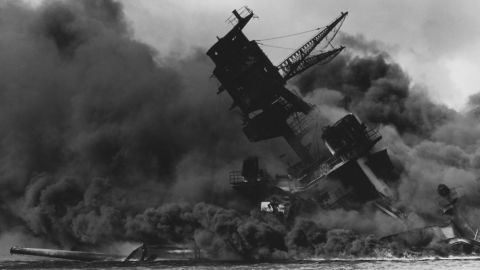Pearl Harbor + 70: A History Buff’s Guide

What’s the Big Idea?
As Wellington said of Waterloo, his greatest victory, it was “the nearest-run thing you ever saw in your life” (this quotation is often amended to “a damn close run thing”). So too was the U.S. Navy’s engagement with the Japanese in the Second World War, particularly during the first tense months following Pearl Harbor as the Japanese rampaged their way across the Pacific. During this stage of the war the fate of empires rested on a relatively small number of men. It would take years for the U.S. to fully militarize its economy and harness the war production that eventually overwhelmed the Japanese. So how did the U.S. Navy shake off its worst defeat at Pearl Harbor and gain the strategic initiative? This story is told in Ian W. Toll’s impressive new book, Pacific Crucible.
Among the heroes of Toll’s history are men who challenged the status quo of a naval culture that was woefully stuck in another era. As Toll notes, for instance, before the war the field of cryptanalysis was “unproven, little understood, and shrouded in secrecy.” In fact, in the late 1920s, Secretary of State Henry Stimson refused to read decrypted foreign communications on ethical grounds. According to Stimson, “gentlemen don’t read each other’s mail.” The times quickly caught up with him. Stimson’s ethical compass turned full circle when he took direct personal control (and with it, many previously unforeseen ethical and moral responsibilities) of the most closely-guarded secret of the entire war, the atomic bomb project.
The best codebreakers, we learn on the other hand, were of an entirely different breed, the sort of men who would never be accused of being gentlemen. In fact, the U.S. codebreakers are described in Pacific Crucible as being “on the verge between brilliance and being crazy,” working twenty-four hour shifts fueled by coffee and benzedrine. These are the men who turned the tide of the war at the Battle of Midway.
Toll’s is one of a handful of new histories being released as the U.S. commemorates the 70th anniversary of Pearl Harbor, the event that marked America’s entry into the defining conflict of the 20th century. A few of these histories offer invaluable lessons for the 21st century. How can individuals and groups of people adapt to overcome seemingly insurmountable odds? The answer can be found in the history of this conflict again and again.
What’s the Significance?
Due to its dwindling numbers and the health of its members, The Pearl Harbor Survivors Association will be dissolving at the end of this year. An estimated 8,000 are alive today, and most of them are in their late 80s. Based on 2008 numbers, World War II veterans in general are dying at a rate of 1,000 per day.
Fortunately, great efforts have been made to preserve the oral history of the Second World War. One classic example is Studs Terkel’s oral history, The Good War. There is also the Veterans History Project at the National Archives. (An interesting side note: since we rely so heavily on electronic communications these days, and tend to be lackadaisical when it comes to preserving our correspondences, it has been a cause for concern that we are in danger of losing our historical record. While it may seem like Big Brother to some, the Library of Congress wants to collect the entire Twitter archive to preserve historically valuable material, which is that institution’s unique mandate. What do you think about that? Let us know in the comments below.)
Now back to World War II. Another noteworthy offering is from the historian Max Hastings, who recently published Inferno: The World at War, 1939-1945, which is based on firsthand testimonies culled from interviews, diaries, letters, memoirs and other personal documents. Hastings seeks to gain an understand of our history not just in broad strokes, but also through the fears and stresses and “simple sorrows” of ordinary people. He writes that the conflict should be “understood as a human experience which changed the lives of hundreds of millions of people, many of whom never saw a battlefield.”
While there have been many hundreds of books published on the Second World War, Toll’s and Hasting’s works are clear standouts. If you don’t have time to read another 400 or 500-page tome on the most documented war in history, you can follow the Twitter feed, @RealTimeWWII, which provides 140-character retellings of the conflict. This project did not start in 2009. If so, the dates of the tweets would have synched up perfectly with the 70th anniversary of the many bloody confrontations it details. So if you follow now you won’t be learning about Pearl Harbor just yet. Instead you will find yourself immersed in the Soviet-Finnish Winter War of 1939.
During the early stages of that conflict, the feed reports that Finnish soldiers fled at the sight of Soviet tanks, as many of those green recruits had never seen such beasts of modern warfare before. Then we learn how the Finns adapted, much the same way that the Americans did after the near-destruction of their fleet at Pearl Harbor. To stop the Soviet tanks, the Finns introduced an incendiary weapon they dubbed the ‘Molotov cocktail.’
To make peace, study war, an old sage once said. Please share your suggestions below.
Follow Daniel Honan on Twitter @DanielHonan





